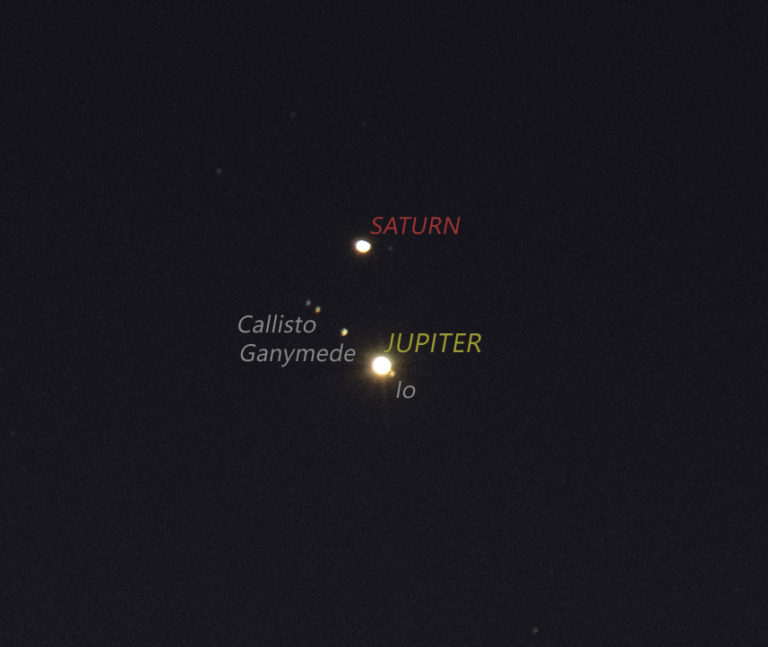Imaged with a FujiFilm X-T2 and a 55-200m zoom lens (set to 200mm). Camera mounted on a Skywatcher Star Adventurer to prevent smearing of the image due to 7 second exposures at that focal length. Imaged at F4 and ISO 800. Jupiter and Saturn Conjunction 20 December 2020, with aircraft landing at East Midlands airport! This set of pictures was taken almost one day before the planets’ closest approach and were taken on 20 December 2020 at 17:20. The closest approach itself was on the 21st December at 18:00 but that day was clouded out with very heavy rain where I live (as usual, most astronomy special events are clouded out in the UK – typical!). Jupiter and Saturn were around 32 arcminutes apart when this picture was taken, moving to their closest at around 30 arcminutes at their closest the following day. 30 arcminutes is about the same diameter…
I had to get up early in the morning to get this picture of The Moon. I set my alarm and got up at 05:00 which took considerable motivation, especially since it was -6C! I don’t capture many last quarter and later moon pictures because the Moon is only ever visible in that phase early in the morning and working full time it is not easy to be getting up very early when you have to do lots of driving. However, conditions for astronomy in the UK have been exceptionally poor for the last six months of 2020 and I am desperate to be able to image anything at all! The Moon, LRGB TEC140 Refractor Technical Details The Moon was in Scorpio, low down to The South from my location, and seeing was average with the Moon at such a low altitude Phase is 38% waning.Imaged from my back garden…
The Moon at a 99% waning phase 30 Dec 2020 between 21:30 and 22:20. Note the bluish and tan colours of the mare (seas). Moon with LRGB Filters Technical Details Imaged from my back garden in Nottingham, UK. The Moon was high up in the constellation of Cancer and seeing was very good – unusual in the UK. TEC140 refractor and ASI174M camera. The image scale is such that I had to capture two runs with each filter to capture the North and The South parts of The Moon and then stitch the two together in Photoshop using the Merge tool. I used LRGB filters and captured 10000 frames in RGB and 20000 in luminance. Data set was in excess of 500 Gigabytes! I then used Autostakkert, Photoshop and PixInsight to process. Capture software in Sharpcap.
LRGB Image of the Moon, TEC 140, 24 Dec 2020 Technical Details This image of The Moon is a composite picture taken with my TEC140 refractor and an ASI174M high speed mono camera through Baader LRGB and Neodymium filters – the same filters that can be used for Deep Sky imaging (and I have used them for exactly that purpose too).Moon is in a 73% waxing gibbous phase in the constellation of Taurus.I captured 2000 frames through the Baader luminance filter and another 2000 through the neodymium filter. I then registered and combined the master image from each of these with Pixelmath with scaling. I used Multi-Scale linear transformation to sharpen the image and a very slight HDR transformation to bring out the fainter detail. This created the master luminance.Each master R, G and B sub is the best 50% of 5000 frames. I registered the separate RGB channels with…
This is a one shot colour picture of The Moon through my Takahashi FSQ85 telescope and my QHY268C colour camera. Seeing between bouts of cloud dodging was quite good with very little in the way of shimmering. This is the best 40% of 5000 frames captured with Fire Capture. I did not use the full resolution of the QHY268’s 6000×4000 sensor, I just captured the central 1600×1200. Unusual to see the FSQ85 used as a planetary or lunar scope but it does excel at this as well as deep sky astrophotography work. It is also a very good instrument for visual observations.Processed with Autostakkert, PixInsight and Photoshop. I hope you like it. It could do with a bit more colour to bring out the colour in the Mare (sea) regions. The Moon 24 Dec 2020 with FSQ85 and QHY268C





